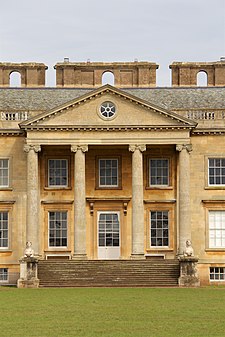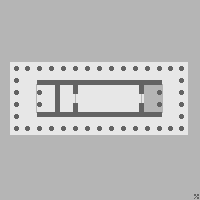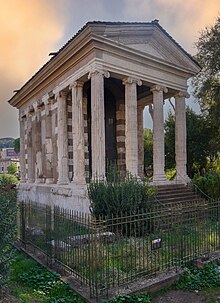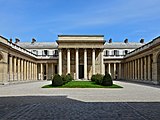Portico
This articleneeds additional citations forverification.(December 2007) |


Aporticois aporchleading to the entrance of a building, or extended as acolonnade,with a roof structure over a walkway, supported bycolumnsor enclosed by walls. This idea was widely used inancient Greeceand has influenced many cultures, including mostWestern cultures.
Porticos are sometimes topped withpediments. Palladiowas a pioneer of using temple-fronts for secular buildings. In theUK,the temple-front applied toThe Vyne,Hampshire, was the first portico applied to anEnglish country house.
Apronaos(UK:/proʊˈneɪ.ɒs/orUS:/proʊˈneɪ.əs/) is the inner area of the portico of aGreekorRoman temple,situated between the portico's colonnade or walls and the entrance to thecella,or shrine. Roman temples commonly had an open pronaos, usually with only columns and no walls, and the pronaos could be as long as thecella.The wordpronaos(πρόναος) isGreekfor "before a temple". InLatin,a pronaos is also referred to as ananticumorprodomus.The pronaos of a Greek and Roman temple is typically topped with a pediment.
Types
[edit]The different variants of porticos are named by the number of columns they have. The "style" suffix comes from the Greekστῦλος,"column".[1]In Greek and Roman architecture, the pronaos of a temple is typically topped with apediment.[2]
Tetrastyle
[edit]
The tetrastyle has four columns; it was commonly employed by theGreeksand theEtruscansfor small structures such as public buildings andamphiprostyles.
TheRomansfavoured the four columned portico for theirpseudoperipteraltemples like theTemple of Portunus,and for amphiprostyle temples such as theTemple of Venus and Roma,and for theprostyleentrance porticos of large public buildings like theBasilica of Maxentius and Constantine.Roman provincial capitals also manifested tetrastyle construction, such as theCapitoline TempleinVolubilis.
The North Portico of theWhite Houseis perhaps the most notable four-columned portico in the United States.
Hexastyle
[edit]Hexastyle buildings had six columns and were the standardfaçadein canonical GreekDoricarchitecture between the archaic period 600–550 BCE up to theAge of Pericles450–430 BCE.
Greek hexastyle
[edit]
Some well-known examples of classical Doric hexastyleGreek temples:
- The group at Paestumcomprising the Temple ofHera(c.550 BCE), the Temple ofApollo(c.450 BCE), the first Temple ofAthena( "Basilica" ) (c.500 BCE) and the second Temple of Hera (460–440 BCE)
- TheTemple of AphaeaatAeginac.495 BCE
- Temple E atSelinus(465–450 BCE) dedicated to Hera
- TheTemple of Zeus at Olympia,now a ruin
- Temple F or the so-called "Temple of Concordia"atAgrigentum(c.430 BCE), one of the best-preserved classical Greek temples, retaining almost all of itsperistyleandentablature
- The "unfinished temple" atSegesta(c.430 BCE)
- TheTemple of Hephaestusbelow theAcropolisat Athens, long known as the "Theseum" (449–444 BCE), also one of the most intact Greek temples surviving from antiquity
- The Temple ofPoseidonon CapeSunium(c.449 BCE)[3]
Hexastyle was also applied toIonictemples, such as the prostyle porch of the sanctuary of Athena on theErechtheum,at theAcropolis of Athens.
Roman hexastyle
[edit]With the colonization by the Greeks ofSouthern Italy,hexastyle was adopted by theEtruscansand subsequently acquired by theancient Romans.Roman taste favoured narrowpseudoperipteralandamphiprostylebuildings with tall columns, raised onpodiumsfor the added pomp and grandeur conferred by considerable height. TheMaison CarréeatNîmes,France,is the best-preserved Roman hexastyle temple surviving fromantiquity.
Octastyle
[edit]
Octastyle buildings had eight columns; they were considerably rarer than the hexastyle ones in the classical Greek architecturalcanon.The best-known octastyle buildings surviving from antiquity are theParthenoninAthens,built during the Age of Pericles (450–430 BCE), and thePantheoninRome(125 CE). The destroyedTemple of Divus Augustusin Rome, the centre of theAugustancult, is shown on Roman coins of the 2nd century CE as having been built in octastyle.
Decastyle
[edit]The decastyle has ten columns; as in the temple ofApolloDidymaeus atMiletus,and the portico ofUniversity College London.[1]
The only known Roman decastyle portico is on theTemple of Venus and Roma,built by Hadrian in about 130 CE.[4]
Gallery
[edit]- Short visual history of porticos
-
Baroqueporticos of theLouvre Colonnade(Paris)
-
Louis XVIportico of the Théâtre de la reine, part of thePetit Trianon(France)
-
Neoclassicalportico of thePalais de la Légion d'Honneur(Paris)
-
Romanian Revivalportico of the Ștefan Lilovici House (Bucharest)
See also
[edit]- Classical architecture– Architectural style, inspired by classical Greco-Roman architectural principles
- Cloister– Open space surrounded by covered walks or open galleries
- Gatehouse– Entry control building
- Gate tower– Fortified tower at a major gateway
- Hypostyle– Hall with a roof supported by columns
- Loggia– Covered exterior gallery, one side open
- Outline of classical architecture– Architectural style, inspired by classical Greco-Roman architectural principles
- Portal (architecture)– Access opening in a wall of a structure
- Porte-cochère– Roofed shelter outside a doorway
- Stoa– Covered walkway in ancient Greece
- Veranda– Roofed, open-air hallway or porch
Citations
[edit]- ^abChisholm, Hugh,ed. (1911)..Encyclopædia Britannica.Vol. 7 (11th ed.). Cambridge University Press. p. 910.
- ^Gates, Charles (2013).Ancient Cities: The Archaeology of Urban Life in the Ancient Near East and Egypt, Greece and Rome.New York: Taylor and Francis. p. 209.ISBN9781134676620.
- ^W. Burkert,Greek Religion(1987)
- ^Sturgis, Russell (1901)."Decastyle".A Dictionary of Architecture and Building: Biographical, Historical and Descriptive.Vol. 1. Macmillan. p. 755.ISBN978-0-7222-2967-5.
- ^Caird, Joe (16 January 2009)."Bologna city guide: top five sights".The Daily Telegraph.Archivedfrom the original on 2022-01-12.Retrieved1 June2013.
General and cited references
[edit]- "Greek architecture".Encyclopædia Britannica.1968.
- Stierlin, Henri (2004).Angelika Taschen(ed.).Greece: From Mycenae to the Parthenon.Cologne:Taschen.ISBN3-8228-1225-0.
- Stierlin, Henri (2002). Silvia Kinkle (ed.).The Roman Empire: From the Etruscans to the Decline of the Roman Empire.Cologne:Taschen.ISBN3-8228-1778-3.

















![The Portico of San Luca in Bologna, Italy, which is possibly the world's longest.[5]](https://upload.wikimedia.org/wikipedia/commons/thumb/3/3f/Bologna_san_luca-5.jpg/80px-Bologna_san_luca-5.jpg)